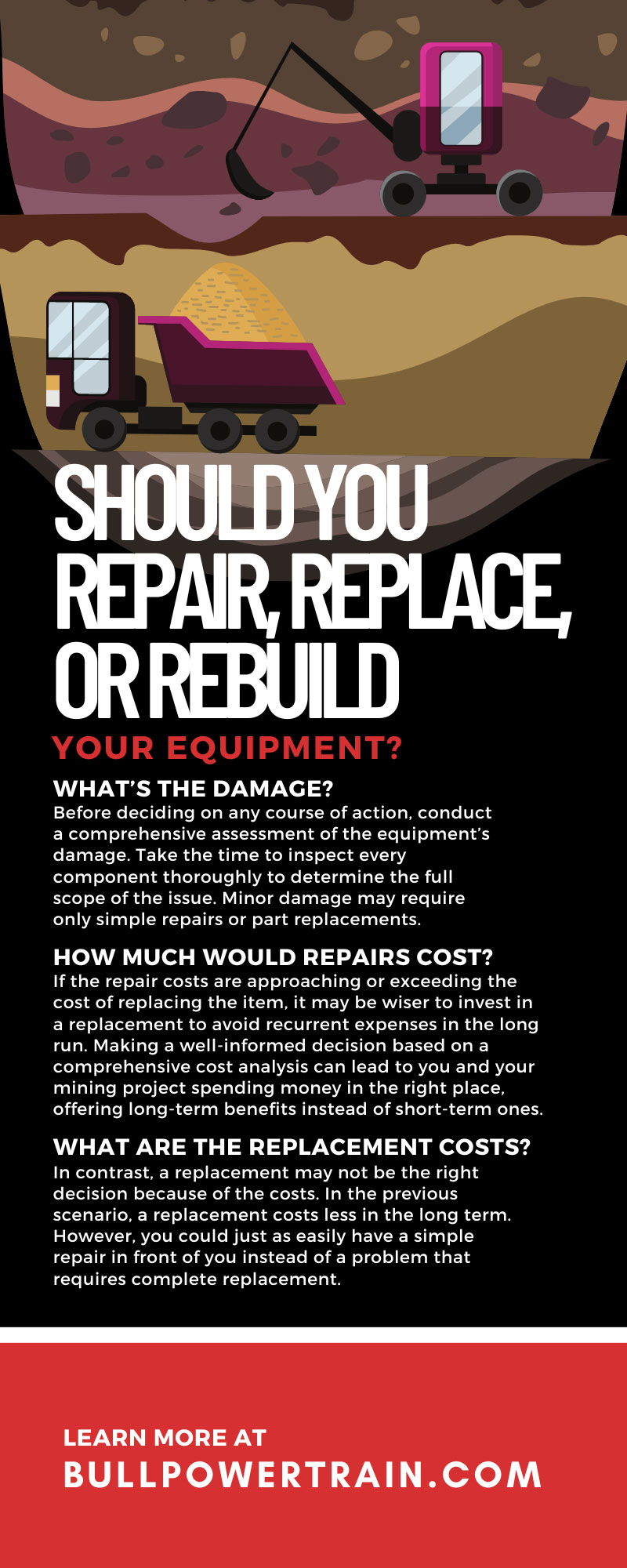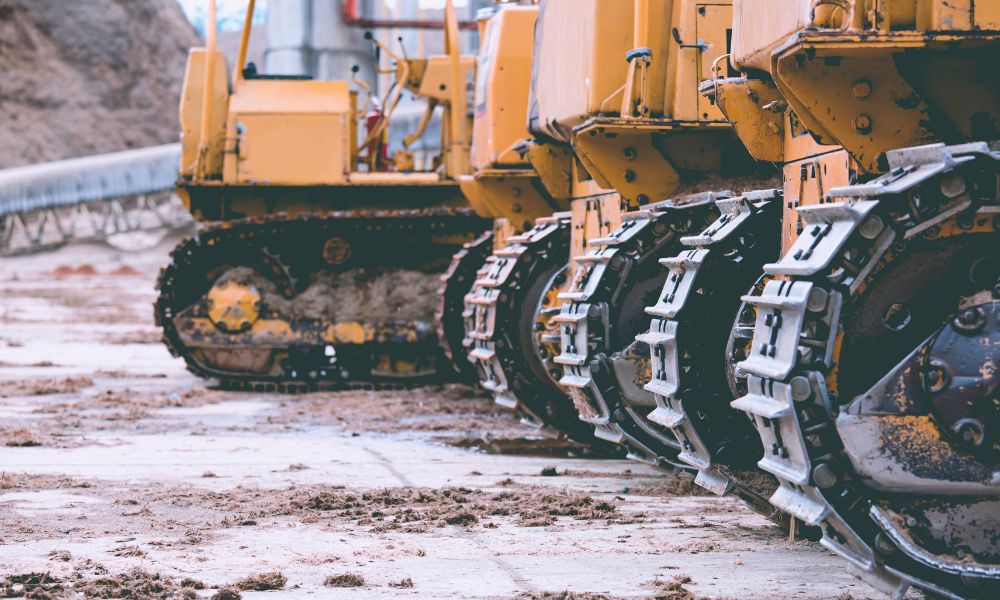The world of mining is vast and complicated from the outside in, but even in the mining industry, there are no simple answers. For example, if you have a piece of off-highway mining equipment that’s not working as it should, it’s hard to know what to do. You could repair, replace, or rebuild your equipment, but what should you do? With the right understanding of your equipment and the variables involved, you can make the choice that’s right for you and your mining operation.
How Old Is Your Equipment?
One of the key aspects to consider when deciding on repairs, replacements, or rebuilds is the age of your equipment. Newer machinery tends to be easier to fix, given the availability of parts and technological advancements.
On the other hand, older equipment might require more involved repairs or even a full replacement, as sourcing parts can be challenging, and advancements in technology may have rendered them obsolete. Weigh the pros and cons based on the age of your equipment to make the most informed decision.
What’s the Damage?
Before deciding on any course of action, conduct a comprehensive assessment of the equipment’s damage. Take the time to inspect every component thoroughly to determine the full scope of the issue. Minor damage may require only simple repairs or part replacements. Here are some examples of minor damage:
- Surface scratches
- Minor dents
- Fluid buildup
On the other hand, severe damages, like structural failures or major component malfunctions, might point toward a complete replacement or rebuild as the more cost-effective solution.
How Much Would Repairs Cost?
When considering repairs, thoroughly assess the associated costs. Consider not only the direct repair expenses but also potential future maintenance costs. If the repair costs are approaching or exceeding the cost of replacing the item, it may be wiser to invest in a replacement to avoid recurrent expenses in the long run. Making a well-informed decision based on a comprehensive cost analysis can lead to you and your mining project spending money in the right place, offering long-term benefits instead of short-term ones.
What Are the Replacement Costs?
In contrast, a replacement may not be the right decision because of the costs. In the previous scenario, a replacement costs less in the long term. However, you could just as easily have a simple repair in front of you instead of a problem that requires complete replacement. Additionally, be sure to evaluate additional expenses such as the following:
- Transportation costs
- Installation fees
- Potential maintenance costs
These detailed assessments will provide a comprehensive overview of the total investment required for the new equipment, helping you determine whether a simple repair is worth the risk.
What Are the Long-Term Maintenance Costs?
When you’re thinking about your equipment investments, remember it’s not just the upfront costs that matter. As we mentioned already, taking a close look at the long-term maintenance expenses is crucial for both repaired and brand-new equipment.
Opting for a newer model with reduced maintenance requirements can turn out to be a wise and budget-friendly strategy in the long run. However, this isn’t always the case.
What Is Your Equipment’s Resale Value?
Before deciding whether to opt for replacement or rebuilding, invest time in thoroughly researching the resale value of your equipment. This step can provide you with valuable insights into finding the most suitable course of action. If you discover that your equipment holds a good resale value, selling it could potentially help alleviate the financial burden associated with upgrades or replacements.
What’s the Impact of Downtime?
When weighing the decision between repair and replacement options, carefully consider the potential operational downtime that would follow. The duration of downtime can substantially impact productivity levels, affecting the overall efficiency and performance of your project.
You must avoid disruptions if you want your project to remain productive. To keep disruptions at a minimum, opt for the option that is best for your equipment’s long-term stability, whether that is a repair or a replacement.
What Are the Safety Risks?
Ensuring safety is paramount in any mining operation to protect the well-being of workers and prevent accidents. The proactive identification and swift resolution of safety risks play a vital role in maintaining a safe work environment. In specific situations, choosing to replace or rebuild equipment instead of opting for repairs can significantly boost operational safety and efficiency over an extended period. This mitigates immediate hazards and contributes to the overall reliability and sustainability of the mining operation.
How Strong Is Part Availability?
When dealing with aging equipment, assess the challenges that may arise in sourcing replacement parts. If locating the necessary components proves to be difficult, you should weigh the practicality of opting for replacements versus repairs. This careful evaluation ensures that you choose the most efficient and cost-effective solution to maintain your equipment’s functionality.
How Is Your Equipment’s Performance?
Regularly assessing the performance of your equipment is crucial to ensure it meets industry standards. By checking for subpar performance indicators, such as decreased output or wear and tear, you can effectively determine if replacement or rebuilding is necessary to maintain optimal performance levels. Plus, when you stay vigilant and monitor performance metrics, you can address issues promptly before they spiral out of control.
Would Upgrades Help Your Operations?
Carefully assess your mining equipment choices by factoring in the latest technological advancements. Newer models often boast advanced features that enhance productivity and improve efficiency, making replacements or rebuilds attractive options. Taking the time to learn about these potential upgrades can have a substantial influence on your decision-making. When you consider upgrades and tech, you can ensure you’re making the right choice for your equipment and mining operation.
What Are Your Future Needs?
Anticipating the evolving needs of your mining operations is crucial for long-term success. Considering technological advancements, changes in production demands, and potential growth opportunities will help you choose between repairing, replacing, or rebuilding your mining equipment. Strategically planning ensures that productivity in your mining project is easy.
The decision to repair, replace, or rebuild your off-highway mining equipment is a nuanced one because there are plenty of factors to consider. However, what you should do becomes clearer when you consider age, damage, costs, and safety, among many other variables.
If you need to replace some components or you need DANA driveline parts, let Bull Powertrain help. We’re the premier supplier of off-highway mining parts. With us on your side, your mining project can run safely and efficiently.


